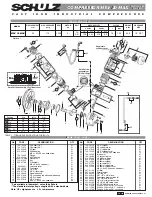
4
GENERAL SAFETY RULES
Keep the exterior of the air compressor dry, clean, and
free from oil and grease. Always use a clean cloth when
cleaning. Never use brake fluids, gasoline, petroleum-
based products, or any strong solvents to clean the unit.
Following this rule will reduce the risk of deterioration of
the enclosure plastic.
SERVICE
Tool service must be performed only by qualified
repair personnel. Service or maintenance performed by
unqualified personnel may result in a risk of injury.
Disconnect power supply, open drain valve to
decompress tank and allow water to drain, and allow
air compressor to become cool to the touch before
servicing. Turn pressure regulator knob fully clockwise
after shutting off compressor.
When servicing a tool, use only identical replacement
parts. Follow instructions in the Maintenance section
of this manual. Use of unauthorized parts or failure to
follow Maintenance instructions may create a risk of
injury.
Know your power tool. Read operator’s manual care-
fully. Learn its applications and limitations, as well as the
specific potential hazards related to this tool. Following
this rule will reduce the risk of electric shock, fire, or seri-
ous injury.
Drain tank of moisture after each day’s use.
If unit will not be used for a while, it is best to leave drain
valve open until such time as it is to be used. This will
allow moisture to completely drain out and help prevent
corrosion on the inside of tank.
Risk of Fire or Explosion. Only spray flammable liquids
such as paints or lacquers. Never spray flammable liquids
in a confined area. Spray area must be well ventilated. Do
not smoke while spraying or spray where spark or flame
is present. Keep compressors as far from the spraying
area as possible, at least 0 feet from the spraying area
and all explosive vapors.
Risk of Bursting. Do not adjust regulator to result in
output pressure greater than marked maximum pressure
of attachment. Do not use at pressure greater than 15
psi.
Risk of Injury. Do not direct air stream at body. Do not
used compressed air for breathing. Do not carry while
painting.
If connected to a circuit protected by fuses, use time-
delay fuses with this product.
This equipment incorporates parts, such as snap
switches, receptacles, and the like that tend to pro-
duce arcs or sparks and, therefore, when located in a
garage, it should be in a room or enclosure provided for
the purpose, or should be 18 in. (457 mm) or more above
the floor.
To reduce the risk of electric shock, do not expose to
rain. Store indoors.
Inspect tank yearly for rust, pin holes, or other im-
perfections that could cause it to become unsafe.
Never weld or drill holes in the air tank.
Make sure the hose is free of obstructions or snags.
Entangled or snarled hoses can cause loss of balance or
footing and may become damaged.
Use the air compressor only for its intended use. Do
not alter or modify the unit from the original design
or function.
Always be aware that misuse and improper handling
of this tool can cause injury to yourself and others.
Never leave a tool unattended with the air hose at-
tached.
Do not operate this tool if it does not contain a legible
warning label.
Do not continue to use a tool or hose that leaks air or
does not function properly.
Always disconnect the air supply and power supply
before making adjustments, servicing a tool, or when a
tool is not in use.
Do not attempt to pull or carry the air compressor by
the hose.
Your tool may require more air consumption than this
air compressor is capable of providing.
Never store tool with air connected. Storing the tool
with air connected can result in unexpected firing and
possible serious personal injury.
Always follow all safety rules recommended by the
manufacturer of your air tool, in addition to all safety
rules for the air compressor. Following this rule will
reduce the risk of serious personal injury.
Never direct a jet of compressed air toward people or
animals. Take care not to blow dust and dirt towards
yourself or others. Following this rule will reduce the risk
of serious injury.
SPECIFIC SAFETY RULES
Summary of Contents for H150PL
Page 19: ...NOTES...





































